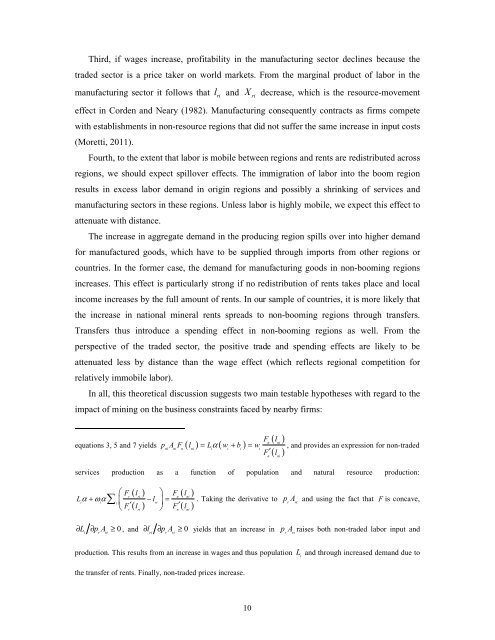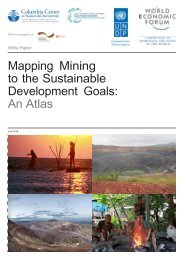Mining matters Natural resource extraction and local business constraints
2fCPiMQ
2fCPiMQ
Create successful ePaper yourself
Turn your PDF publications into a flip-book with our unique Google optimized e-Paper software.
Third, if wages increase, profitability in the manufacturing sector declines because the<br />
traded sector is a price taker on world markets. From the marginal product of labor in the<br />
manufacturing sector it follows that l<br />
ri <strong>and</strong><br />
X<br />
ri decrease, which is the <strong>resource</strong>-movement<br />
effect in Corden <strong>and</strong> Neary (1982). Manufacturing consequently contracts as firms compete<br />
with establishments in non-<strong>resource</strong> regions that did not suffer the same increase in input costs<br />
(Moretti, 2011).<br />
Fourth, to the extent that labor is mobile between regions <strong>and</strong> rents are redistributed across<br />
regions, we should expect spillover effects. The immigration of labor into the boom region<br />
results in excess labor dem<strong>and</strong> in origin regions <strong>and</strong> possibly a shrinking of services <strong>and</strong><br />
manufacturing sectors in these regions. Unless labor is highly mobile, we expect this effect to<br />
attenuate with distance.<br />
The increase in aggregate dem<strong>and</strong> in the producing region spills over into higher dem<strong>and</strong><br />
for manufactured goods, which have to be supplied through imports from other regions or<br />
countries. In the former case, the dem<strong>and</strong> for manufacturing goods in non-booming regions<br />
increases. This effect is particularly strong if no redistribution of rents takes place <strong>and</strong> <strong>local</strong><br />
income increases by the full amount of rents. In our sample of countries, it is more likely that<br />
the increase in national mineral rents spreads to non-booming regions through transfers.<br />
Transfers thus introduce a spending effect in non-booming regions as well. From the<br />
perspective of the traded sector, the positive trade <strong>and</strong> spending effects are likely to be<br />
attenuated less by distance than the wage effect (which reflects regional competition for<br />
relatively immobile labor).<br />
In all, this theoretical discussion suggests two main testable hypotheses with regard to the<br />
impact of mining on the <strong>business</strong> <strong>constraints</strong> faced by nearby firms:<br />
equations 3, 5 <strong>and</strong> 7 yields ( ) α ( b )<br />
p A F l = L w<br />
ni ni n ni i i<br />
+ = w<br />
i i<br />
F<br />
n<br />
F′<br />
n<br />
( l )<br />
ni<br />
( l )<br />
ni<br />
, <strong>and</strong> provides an expression for non-traded<br />
services production as a function of population <strong>and</strong> natural <strong>resource</strong> production:<br />
( )<br />
( )<br />
( )<br />
( )<br />
⎛ F l ⎞ F l<br />
⎜<br />
F′ ⎟<br />
⎝ l ⎠ F′<br />
l<br />
r ri n ni<br />
L i<br />
α + ω i<br />
α ∑ i<br />
− l = . Taking the derivative to ri<br />
r ri<br />
r ri n ni<br />
p A <strong>and</strong> using the fact that F is concave,<br />
∂L<br />
∂p A ≥ 0 , <strong>and</strong> ∂l<br />
∂p A ≥ 0 yields that an increase in p A raises both non-traded labor input <strong>and</strong><br />
i r ri<br />
ri r ri<br />
r ri<br />
production. This results from an increase in wages <strong>and</strong> thus population<br />
the transfer of rents. Finally, non-traded prices increase.<br />
L <strong>and</strong> through increased dem<strong>and</strong> due to<br />
i<br />
10






